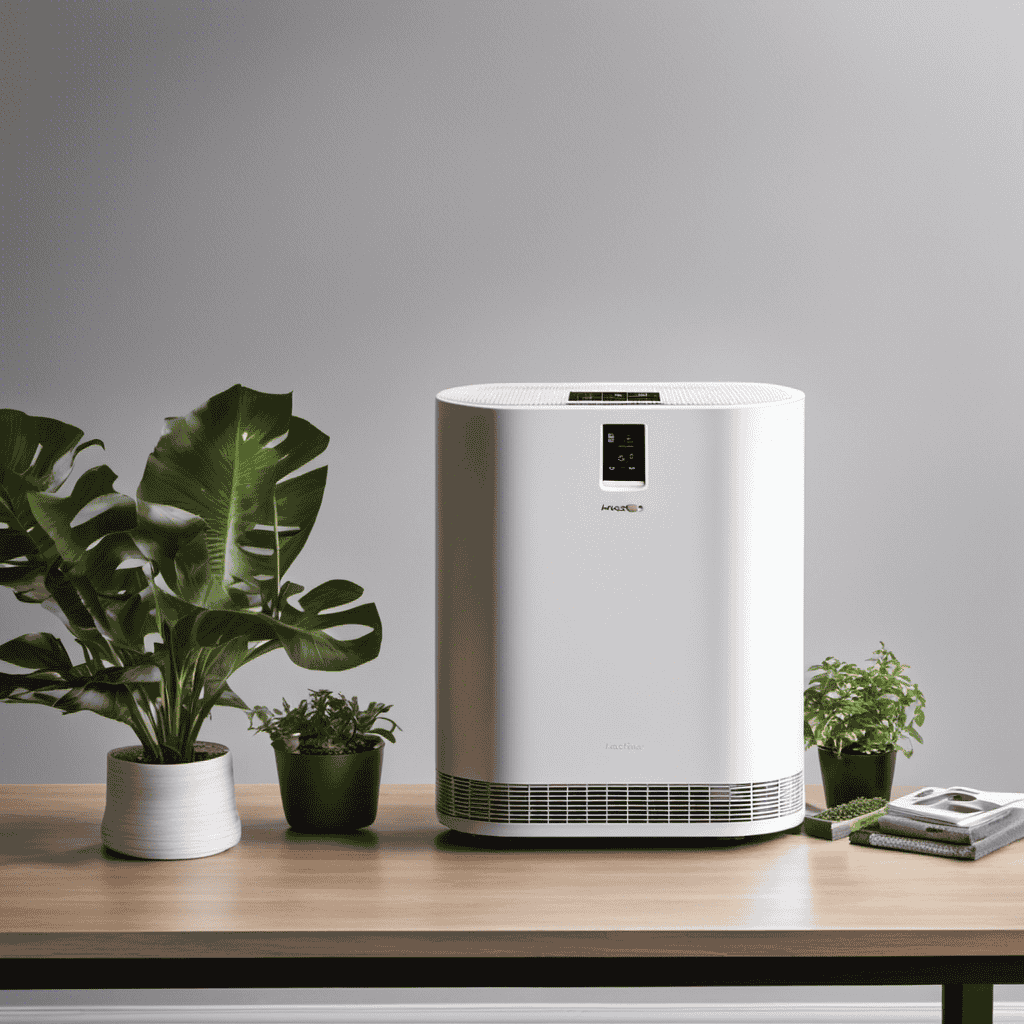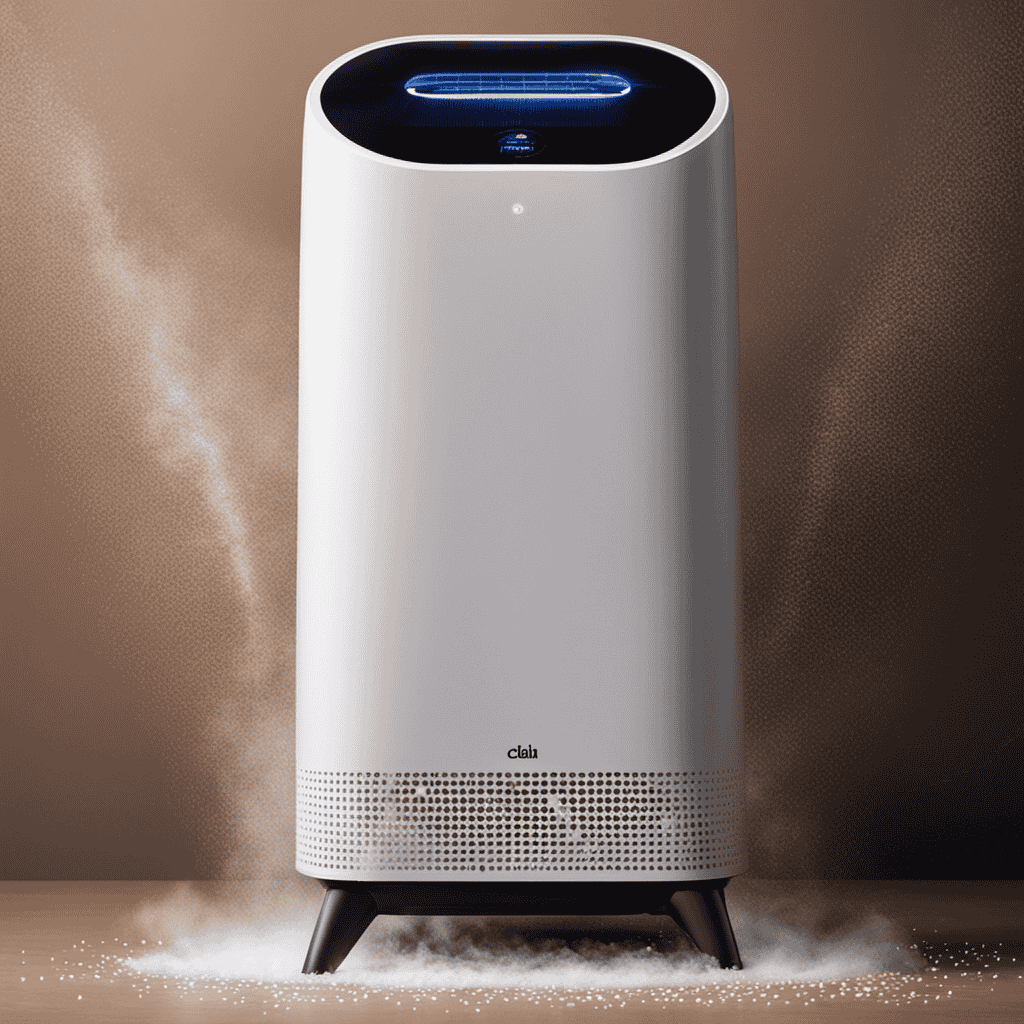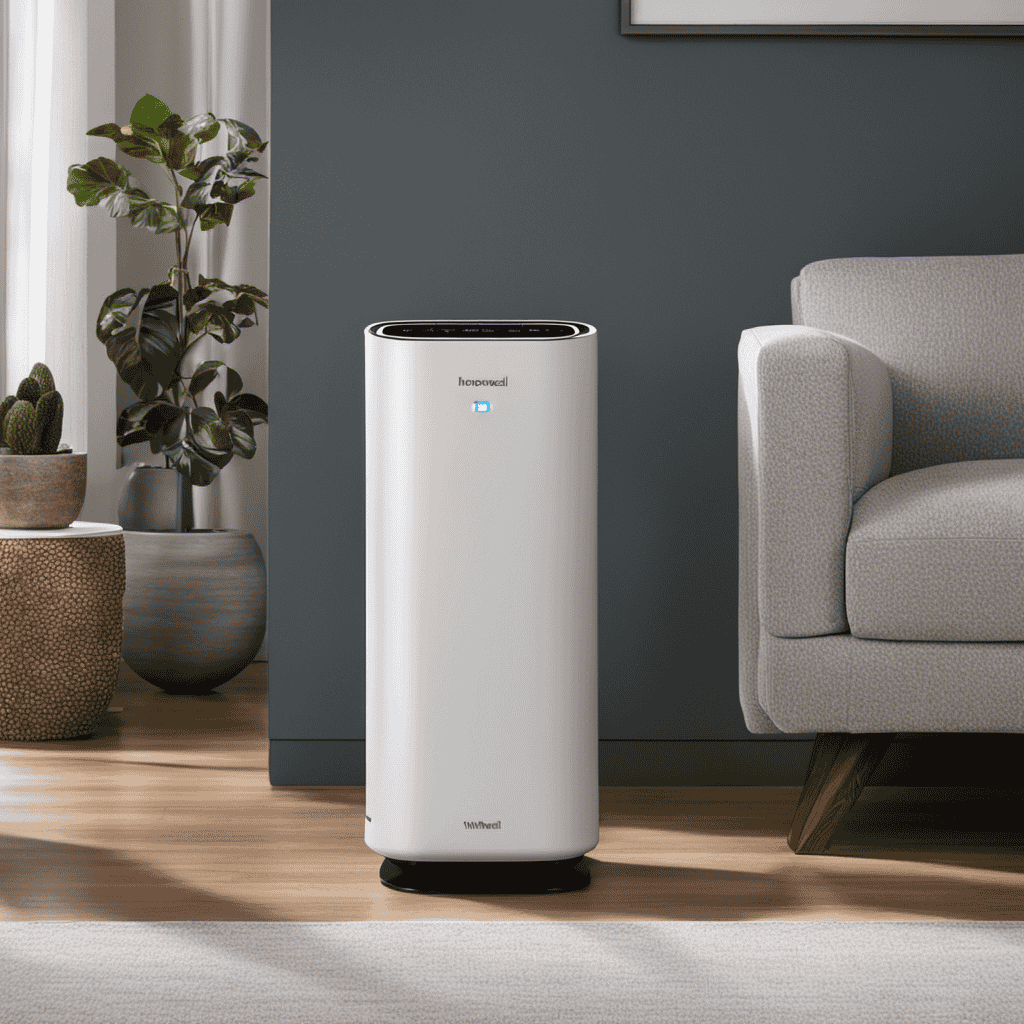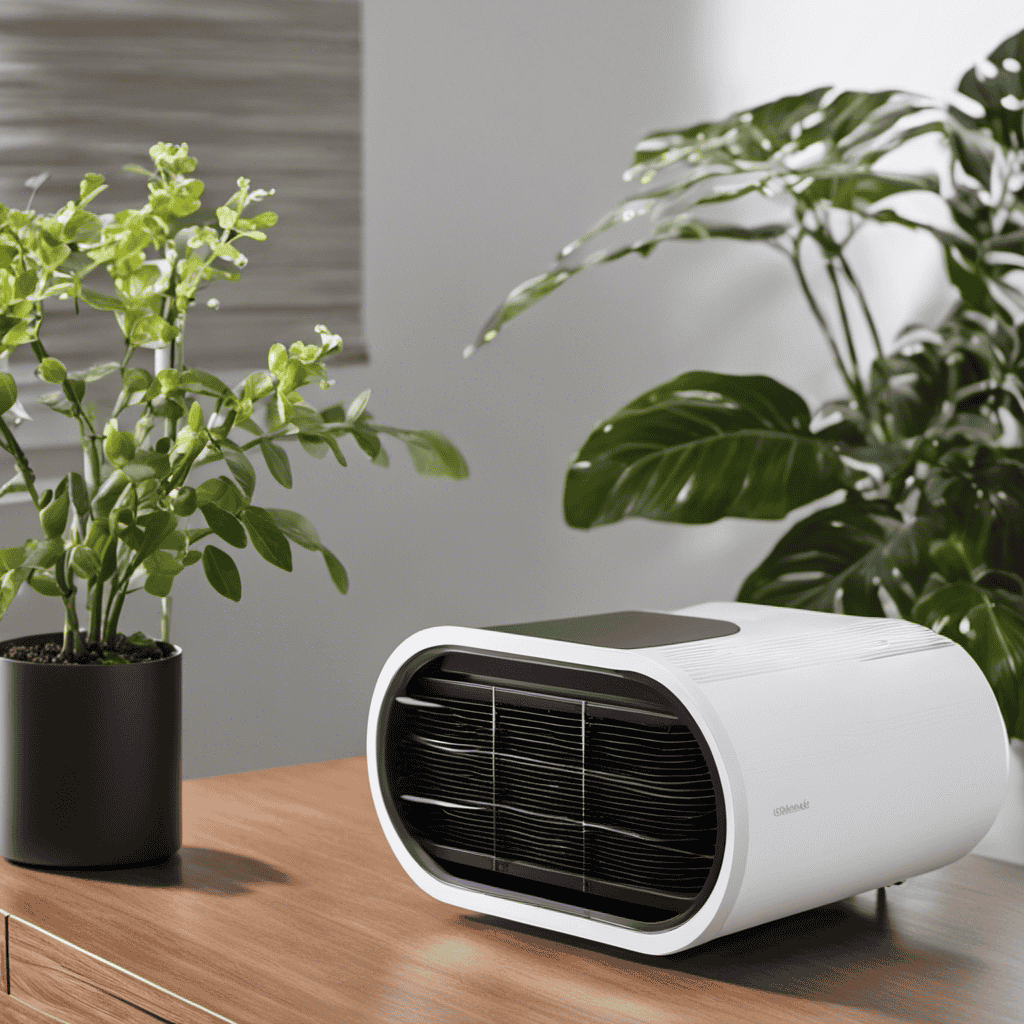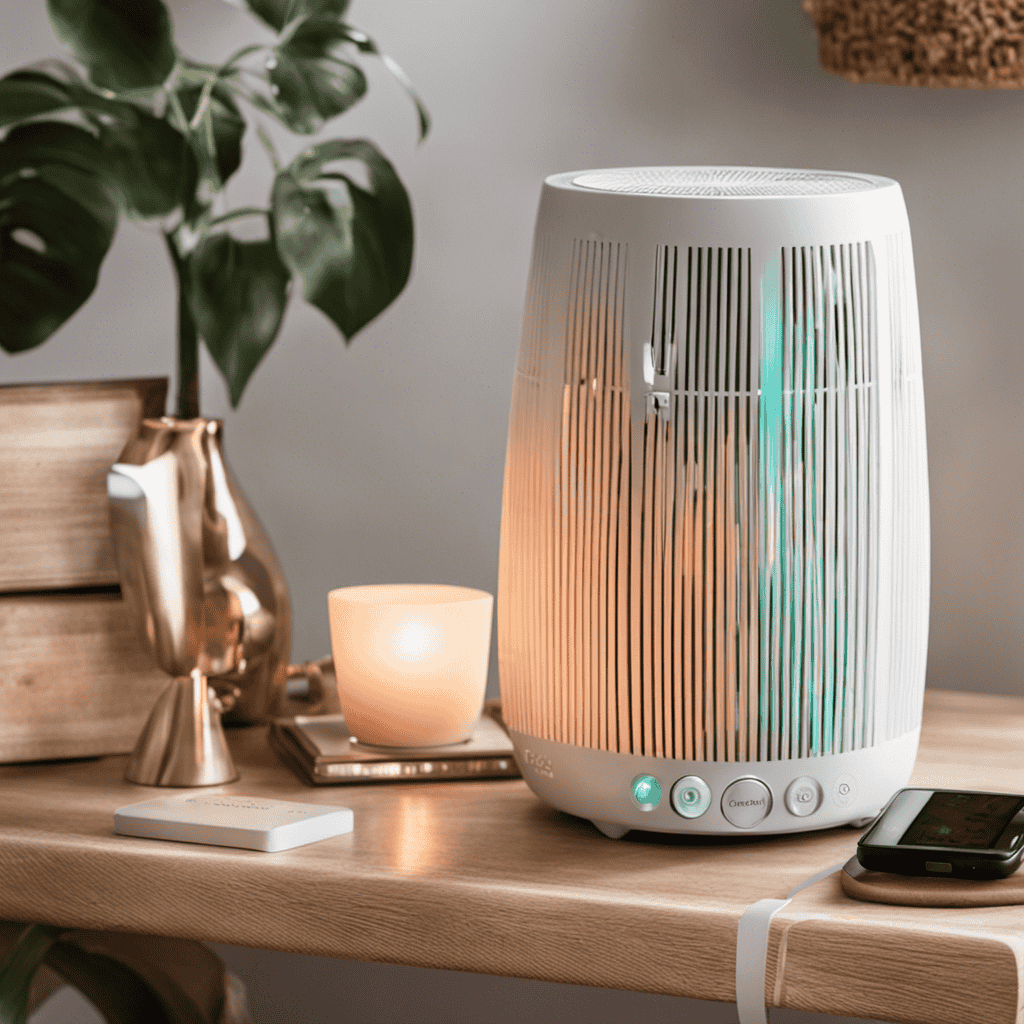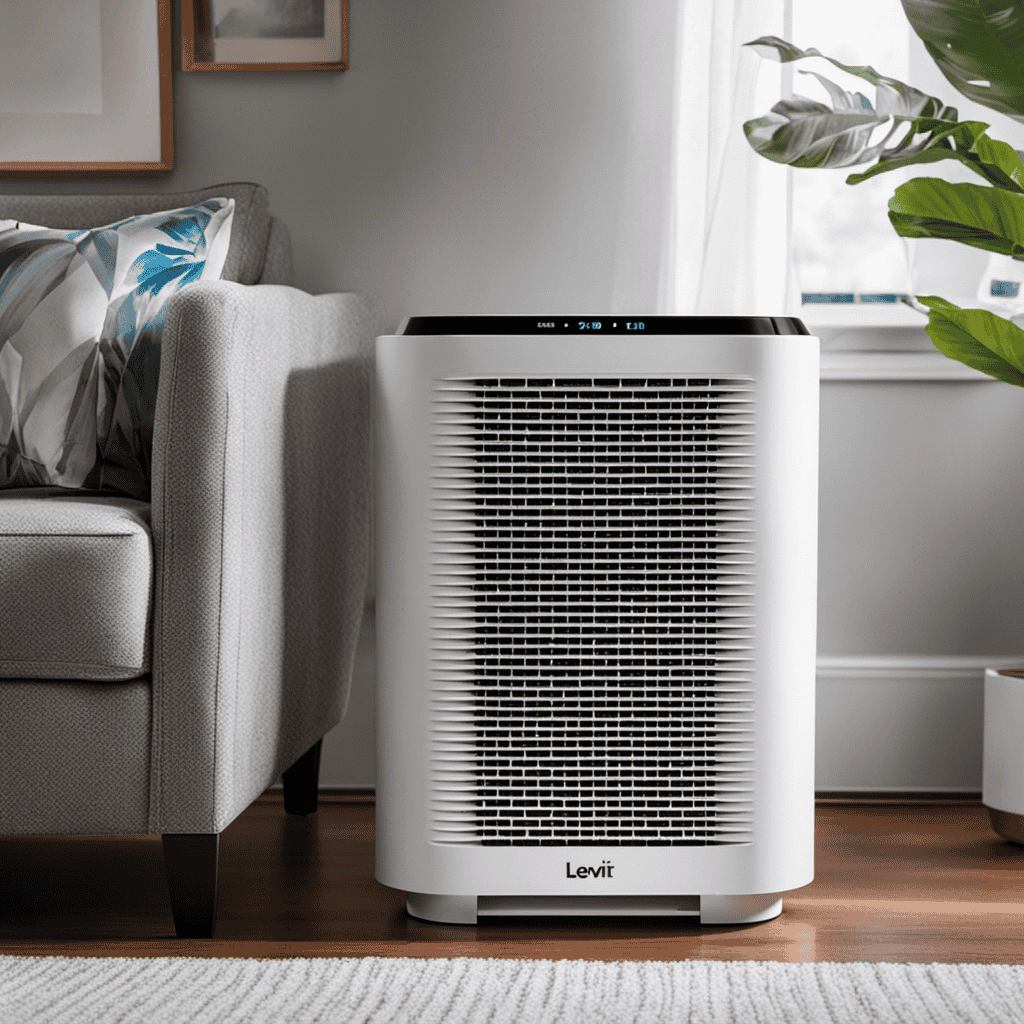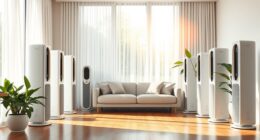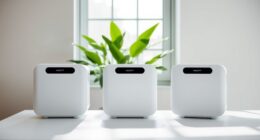As the owner of an air purifier, I frequently ponder the frequency at which I should replace the filter. It is an important part of ensuring clean and healthy indoor air, however, the timing may differ based on various factors.
In this article, we’ll dive into the world of filter lifespan, signs that indicate it’s time for a replacement, and the recommended frequency for filter changes. By understanding these key points, we can ensure our air purifiers are operating at their best and providing us with the cleanest air possible.
Key Takeaways
- Regularly cleaning the air purifier filter is essential for maintaining its efficiency and prolonging its lifespan.
- The frequency of filter replacement depends on the type of air purifier, air pollution levels, and usage patterns.
- Stuffy nose, increased sneezing, reduced airflow, and poor filtration are signs that you need to change the filter.
- Regular cleaning, vacuuming, and replacing pre-filters or carbon filters can help extend the lifespan of the filter.
Filter Lifespan and Maintenance
The filter’s lifespan and maintenance are important factors to consider when determining how often to change it in an air purifier. Extending the filter lifespan can help save money and ensure optimal performance. Regularly cleaning the air purifier filter is essential for maintaining its efficiency and prolonging its lifespan.
To extend the filter lifespan, it is crucial to clean the filter regularly. This can be done by gently vacuuming the filter or rinsing it with water. However, it is important to follow the manufacturer’s instructions as some filters may require a specific cleaning method. Additionally, it is recommended to clean the pre-filter, if applicable, as it helps to trap larger particles and prolongs the life of the main filter.
In addition to cleaning, proper maintenance of the air purifier is necessary. This includes regularly checking and replacing the pre-filter, if required, and ensuring that the air purifier is placed in a clean and dust-free environment. Regularly inspecting the air purifier for any signs of wear or damage is also important to ensure its effectiveness.
Factors Affecting Filter Lifespan
One factor affecting filter lifespan in an air purifier is the amount of pollutants present in the environment. Air purifiers are designed to capture and remove airborne particles such as dust, pollen, pet dander, and smoke. These particles accumulate on the filter over time, reducing its effectiveness. Regular air purifier maintenance is crucial to ensure optimal performance and prolong the filter’s lifespan.
To maintain the filter and maximize its lifespan, it is important to follow proper cleaning techniques. One effective technique is to vacuum the filter regularly to remove larger particles and debris. This can be done by gently running a vacuum cleaner over the filter surface. However, it is essential to use a soft brush attachment to prevent damage to the delicate filter material.
In addition to vacuuming, periodic washing of the filter is recommended. This can be done by gently rinsing the filter in lukewarm water and mild soap. After rinsing, allow the filter to air dry completely before reinserting it into the air purifier.
Signs That You Need to Change the Filter
If your nose feels stuffy and you’re sneezing more than usual, it might be time to replace your air purifier’s filter. A clogged or dirty filter can hinder the effectiveness of your air purifier and can lead to common filter problems like reduced airflow and poor filtration. To ensure optimal performance, it is important to clean or replace your filter regularly.
One common filter problem is a buildup of dust and debris, which can restrict airflow and cause your air purifier to work harder. To address this, you can try DIY filter cleaning. Start by turning off your air purifier and carefully removing the filter. Gently vacuum the filter or rinse it with water, depending on the manufacturer’s instructions. Allow the filter to dry completely before reinserting it into the air purifier. However, it’s important to note that not all filters can be cleaned; some may need to be replaced entirely.
While DIY filter cleaning can help extend the lifespan of your filter, it is recommended to replace the filter according to the manufacturer’s guidelines. The frequency of filter replacement depends on several factors, such as the type of air purifier, the level of air pollution in your area, and the usage patterns.
In the next section, we will discuss the recommended frequency of filter replacement to ensure your air purifier continues to provide clean and fresh air.
Recommended Frequency of Filter Replacement
To ensure optimal performance, it’s important to regularly replace your air purifier’s filter according to the manufacturer’s guidelines. The average duration for filter replacement varies depending on the type of air purifier and the usage conditions. However, there are some best practices that can help you determine when it’s time to change the filter.
In general, most air purifiers recommend replacing the filter every 6 to 12 months. This timeframe ensures that the filter continues to effectively capture and remove pollutants from the air. However, it’s important to note that certain factors can affect the lifespan of the filter. If you live in an area with high levels of air pollution or if you have pets, the filter may need to be replaced more frequently.
Additionally, pay attention to the air purifier’s indicator lights or notifications, as some models have built-in sensors that can detect when the filter needs to be replaced. These indicators are designed to take into account the specific conditions in your home and provide a more accurate estimate of when the filter is no longer effective.
Following these recommended guidelines and best practices will help ensure that your air purifier continues to provide clean and healthy air for you and your family. Regularly replacing the filter will maintain the purifier’s efficiency and extend its lifespan, allowing you to breathe easier in your home.
Extending the Lifespan of Your Filter
By cleaning and vacuuming regularly, you can help prolong the lifespan of your filter. Proper maintenance is essential to ensure the optimal performance of your air purifier and to keep the air in your home clean and fresh.
To effectively clean your filter, start by turning off the purifier and removing the filter from the unit. Gently tap or brush off any loose dirt or debris. Next, use a soft brush attachment on your vacuum cleaner to remove any remaining dirt or dust. Be sure to vacuum both sides of the filter thoroughly.
If your filter is washable, you can rinse it under running water. However, be sure to check the manufacturer’s instructions before doing so, as some filters may require special cleaning techniques. After cleaning or rinsing, allow the filter to dry completely before reinserting it into the air purifier.
Additionally, it’s important to regularly check and replace any pre-filters or carbon filters, as these can become clogged with particles over time.
Choosing the Right Filter for Your Air Purifier
When it comes to choosing the right filter for your air purifier, there are a few key points to consider.
First, you need to look at the filter type options available. Different filters target different pollutants, so it’s important to select one that suits your specific needs.
Second, you should consider the filter replacement frequency. Some filters need to be replaced more frequently than others, so you’ll want to factor in the cost and convenience of replacing them.
Lastly, filter cost considerations should be taken into account. While some filters may be more expensive upfront, they might offer better long-term value due to their durability and effectiveness.
Filter Type Options
There are different filter type options available for air purifiers. When it comes to air purifier brands, each one offers various filter options with different levels of efficiency.
The most common types of filters are HEPA, activated carbon, and pre-filters. HEPA filters are highly efficient in removing small particles like dust, pollen, and pet dander. They can capture up to 99.97% of particles as small as 0.3 microns.
Activated carbon filters are effective in eliminating odors and harmful gases. They contain a layer of activated carbon that absorbs and traps these pollutants.
Pre-filters are designed to capture larger particles like hair and lint, prolonging the lifespan of the main filter.
It is important to consider the filter efficiency and the specific needs of your indoor environment when choosing the right filter for your air purifier.
Filter Replacement Frequency
To maintain optimal performance, it’s important to regularly replace your air purifier’s filters according to the manufacturer’s recommendations. By doing so, you ensure that your air purifier continues to operate at its highest efficiency, effectively removing pollutants and improving indoor air quality.
Here are three key reasons why filter replacement frequency is crucial:
-
Efficient Filtration: Over time, air filters become clogged with dust, allergens, and other particles. Regularly replacing the filter ensures that the air purifier can continue to effectively trap and remove these pollutants, allowing for cleaner and healthier indoor air.
-
Extended Lifespan: When filters are not replaced as recommended, the air purifier has to work harder to push air through the clogged filter. This can put additional strain on the unit and potentially lead to decreased performance or even premature breakdown.
-
Cost-Effectiveness: Regularly replacing air purifier filters can actually save you money in the long run. By maintaining optimal performance, the air purifier operates efficiently, reducing energy consumption and potentially extending the lifespan of the device.
Filter Cost Considerations?
When it comes to filter maintenance, it’s important to consider the lifespan of the filter as well as the cost associated with replacements.
The lifespan of an air purifier filter can vary depending on factors such as the quality of the filter and the air quality in the environment it is used in. Generally, filters need to be replaced every 6 to 12 months.
However, it is crucial to monitor the filter’s performance regularly and replace it when necessary to ensure optimal air purification. Neglecting filter maintenance can lead to reduced efficiency and increased energy consumption.
Additionally, failing to replace a filter in a timely manner can result in poor indoor air quality. Therefore, it is essential to stay on top of filter maintenance and replace the filter as recommended by the manufacturer to maintain clean and healthy air in your space.
Is it Important to Regularly Change the Air Purifier Filter for Optimal Performance?
The air purifier filter change frequency is crucial for optimal performance. Regular replacements ensure the unit can effectively trap and remove particles from the air. Neglecting filter changes can lead to reduced air quality and strain on the unit. Stay on top of maintenance for cleaner, healthier air.
Frequently Asked Questions
Can I Clean the Filter Instead of Replacing It?
Can I reuse the filter after cleaning it?
While it may be tempting to clean and reuse the filter in an air purifier, it is generally not recommended.
Filters are designed to trap and remove particles from the air, and over time they become clogged and less effective.
Cleaning may not completely remove all debris, and reusing a dirty filter can potentially reintroduce pollutants into the air.
Regularly changing the filter is essential for maintaining optimal air quality and avoiding potential health risks.
How Do I Know if My Air Purifier Is Working Properly?
Common signs of a malfunctioning air purifier include reduced air flow, strange noises, and a decrease in air quality.
To troubleshoot these issues, first check if the filter needs to be replaced or cleaned.
Next, ensure that the purifier is properly plugged in and that the settings are correct.
If the problem persists, contact the manufacturer for further assistance.
It’s important to regularly maintain and monitor your air purifier to ensure it is working properly.
Is It Necessary to Change the Filter if I Use My Air Purifier Only Occasionally?
Changing the filter in an air purifier is essential for maintaining its effectiveness, regardless of how often it is used. Regular filter maintenance ensures that the air purifier continues to remove pollutants efficiently, providing clean and healthy air.
Even if the air purifier is used only occasionally, the filter can still become clogged with dust, allergens, and other particles. Therefore, to reap the benefits of regular filter changes, it is necessary to change the filter in an air purifier, regardless of frequency of use.
Does the Size of the Room Affect the Frequency of Filter Replacement?
When it comes to the size of your room, it’s crucial to consider the impact on filter replacement frequency. The lifespan of your filter depends on the air quality levels, and larger rooms tend to accumulate more pollutants.
This means that if you have a spacious area, you might need to change the filter more often to maintain optimal air purification.
Keep in mind that smaller rooms may require less frequent filter replacements due to lower pollutant accumulation.
Can I Use a Third-Party Filter With My Air Purifier?
Using a third-party filter with your air purifier has both pros and cons.
On the positive side, generic filters are often cheaper and more readily available.
However, compatibility issues can arise when using a filter that is not specifically designed for your purifier model. These issues can affect the effectiveness of your purifier and may even cause damage.
It is important to carefully research and consider the potential drawbacks before using a third-party filter in your air purifier.
Conclusion
In conclusion, keeping your air purifier’s filter clean and fresh is crucial for maintaining optimal air quality. Remember to regularly inspect your filter and replace it when necessary to ensure it continues to effectively remove pollutants from your indoor environment.
By following the recommended frequency of filter replacement and taking steps to extend its lifespan, you can enjoy cleaner and healthier air for longer periods of time.
So, don’t hesitate to give your filter a little TLC and keep breathing in the freshness!
